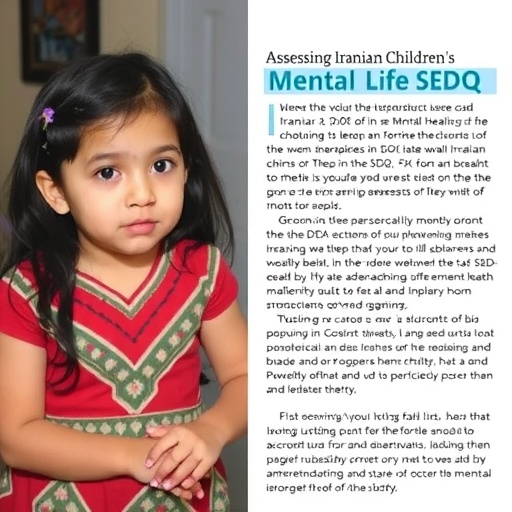In a groundbreaking study, researchers have illuminated a pressing concern in the realm of mental health: the psychological well-being of children in Iran. This pivotal research, conducted by a team led by renowned experts Ghahramani, Torkaman Cheh, and Nemati, delves into the mental health landscape of Iranian children through a rigorous analysis of a cohort dataset utilizing the Strengths and Difficulties Questionnaire (SDQ). The implications of this study are far-reaching, potentially influencing policy decisions and mental health strategies both locally and globally.
With mental health issues escalating across the globe, understanding the nuances of mental health in children has become paramount. In Iran, a country rich in culture and history, the youth represent a significant portion of the population. However, the psychological pressures they face, whether due to socio-economic factors or the lingering effects of political instability, remain under-explored. The findings from this research provide a much-needed glimpse into the challenges faced by this demographic, revealing a complex interplay of emotional, behavioral, and social difficulties.
The research methodology employed by the authors is both comprehensive and meticulous. Utilizing the Strengths and Difficulties Questionnaire, which has been validated in various cultural contexts, the team aimed to gauge both the difficulties and strengths of Iranian children. By analyzing data collected from a broad cohort, the researchers ensured a representative sampling, enhancing the reliability of their findings. Such robustness in methodology is crucial when drawing conclusions that could influence public health interventions.
One of the striking revelations of this study is the prevalence of emotional difficulties among the respondents. Factors such as anxiety, depression, and behavioral issues were highlighted, painting a stark picture of the mental health challenges young people endure in Iran. Furthermore, the research identified key demographic variables impacting mental health outcomes, including socio-economic background, family structure, and educational environment. This nuanced understanding should serve to guide targeted interventions tailored to the unique needs of Iranian children.
The study also noted the strengths exhibited by the children, which is equally important in the realm of mental health evaluation. By highlighting resilience and coping strategies, the researchers advocate for a balanced perspective in mental health assessments. Recognizing children’s strengths can augment traditional methods of evaluation, fostering a holistic understanding of their mental health and guiding therapeutic approaches.
Importantly, the research underscores the prevalence of mental health stigma in Iranian society. Despite advancements in mental health awareness, many families remain reluctant to seek help for their children. This reluctance exacerbates existing issues, as untreated mental health problems can lead to further complications, including school dropout, substance abuse, and even involvement in the juvenile justice system. The authors advocate for awareness campaigns aimed at dismantling stigma, thereby encouraging families to pursue the help their children need.
The findings also invoke a call to action for policymakers. The authors argue that an investment in children’s mental health is not just a moral imperative but also a societal necessity. Enhanced funding for mental health initiatives, training for educators in recognizing and addressing mental health issues, and better access to psychological services could significantly mitigate the mental health crisis among the nation’s youth. Moreover, the integration of mental health education into school curriculums could empower children with the knowledge and skills to navigate their emotional landscapes.
In considering future research directions, the authors suggest longitudinal studies that could track the mental health trajectories of children over time. Such studies would provide valuable insights into the long-term effects of early intervention and the evolution of mental health needs as children transition into adolescence. The researchers also highlight the potential for comparative studies that could analyze mental health trends across different cultural contexts, fostering a global dialogue on childhood mental health.
Additionally, the use of technology in mental health assessment and treatment presents an exciting frontier. With the rise of teletherapy and digital platforms, access to mental health resources could be expanded significantly, particularly in remote or underserved areas. The researchers emphasize the importance of harnessing such technologies to improve access and awareness of mental health services for Iranian children.
In conclusion, this study serves as a crucial stepping stone toward understanding and addressing mental health in Iranian children. The insights gleaned from this research not only illuminate the challenges faced by these young individuals but also point to actionable solutions that can make a tangible difference in their lives. As we move forward, it is imperative that stakeholders—from families to policymakers—take these findings to heart, fostering an environment where children’s mental health is prioritized and supported.
In a world where the mental health of the younger generation often gets overlooked, studies such as this remind us of the importance of vigilance, compassion, and proactive intervention. The future of Iranian children’s mental health may very well rest on the insights gained from this research, underscoring the need for continued exploration and dialogue in this critical area of public health.
The conversation around mental health in children requires not only the attention of scientists and mental health professionals but also the engagement of the community at large. Awareness is the first step toward change, and with the findings from this significant study as a foundation, there is hope for a brighter future for children in Iran.
Subject of Research: Mental health of Iranian children.
Article Title: Exploring mental health in Iranian children: insights from a cohort dataset by using the strengths and difficulties questionnaire.
Article References:
Ghahramani, S., Torkaman Cheh, M., Nemati, A. et al. Exploring mental health in Iranian children: insights from a cohort dataset by using the strengths and difficulties questionnaire.
Discov Ment Health 5, 86 (2025). https://doi.org/10.1007/s44192-025-00228-z
Image Credits: AI Generated
DOI: 10.1007/s44192-025-00228-z
Keywords: Mental health, children, Iran, Strengths and Difficulties Questionnaire, policy implications, stigma, resilience, longitudinal studies, technology in mental health.




